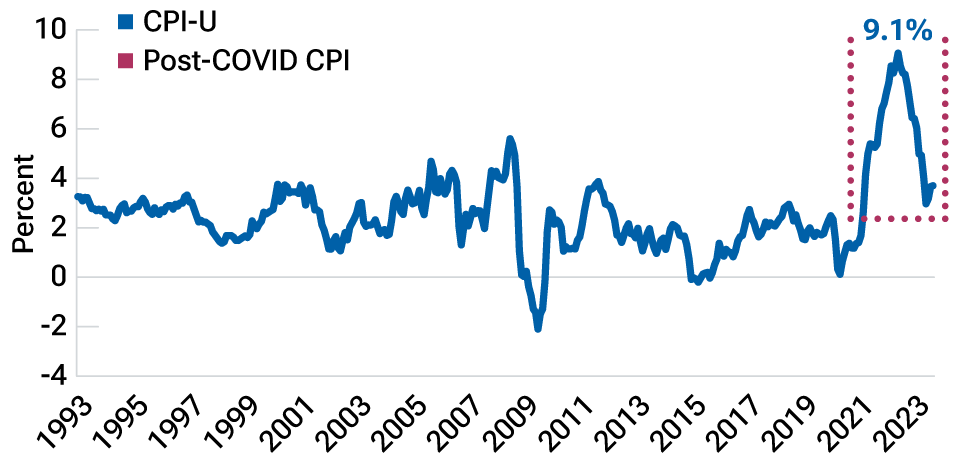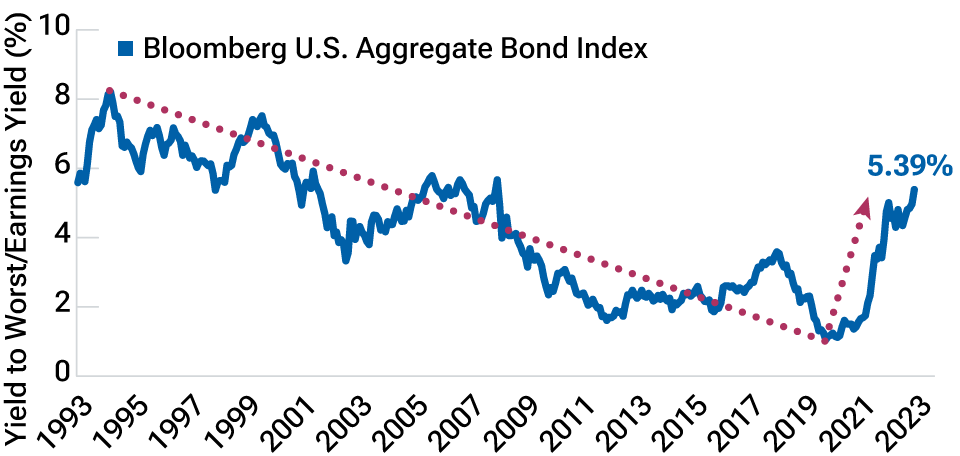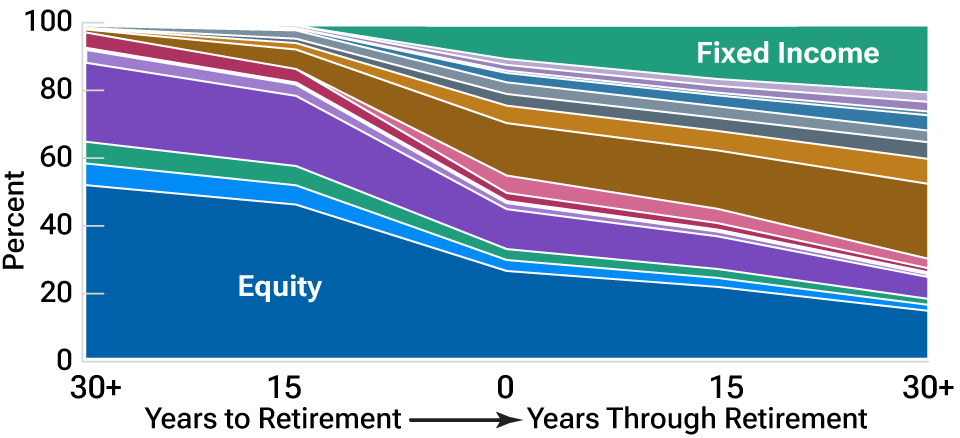March 2024 / RETIREMENT INSIGHTS
#Dontbebasic: Three Reasons to Evaluate Your Target Date Solution
Key Insights
- The main goal of effective diversification is to build a portfolio that is durable and able to weather multiple market environments.
- In an uncertain market, with lingering inflation and interest rate risk, investors need thoughtful diversification across growth and risk mitigation opportunities.
- A long-term view on active management is key as data show that even the most efficient asset classes can offer opportunities for robust alpha in given years.
In a world that increasingly relies on hashtags to communicate, we offer the following on diversification: #Dontbebasic. A “basic” or simplified approach to asset allocation can be a crucial mistake when it comes to constructing target date solutions, which are intended to support investors over long time horizons that will include a range of market environments.
While target date solutions are inherently diversified, given their multi‑asset exposures and dynamic glide path, the level of diversification and its purpose can vary meaningfully across providers. By “diversification,” we mean using a mix of investments that either enhance returns or mitigate risk to drive outcomes in a portfolio.1 Without the right level of diversification, retirement savers may be missing out on opportunities or taking on too much risk over the course of their retirement journeys. Here are three reasons why it’s important to go beyond “basic” when evaluating target date solutions.
#Dontbebasic reason no. 1: Things have changed
We are no longer in a “basic” market environment, so retirement savers cannot afford a basic approach to asset allocation. For most of the past decade, investors were well served with beta exposure. There were some notable exceptions (here’s looking at you, calendar year 2022!), and we believe financial markets will be more discriminating in the future. Furthermore, for the past decade, inflation was not a concern, but this is no longer the case (Figure 1). Inflation surged to 9% in mid-2023, and while these elevated levels have since abated, inflation risk lingers as spillover effects from geopolitical tensions are causing renewed supply chain disruptions, which are once again having impacts on goods and transportation prices.
The inflation and interest rate environment has shifted
(Fig. 1) Inflation and interest rate data over the past 30 years


1 Source: Bureau of Labor Statistics.
2 Source: Bloomberg Finance L.P.
Past performance is not a reliable indicator of future performance.
Concerns around inflation and its potential to erode purchasing power remains high for retirees. Our research shows that 75% of retirees are worried about the impact of inflation on their retirement—significantly outpacing other concerns, such as “running out of money” (45%) and “not knowing life expectancy” (44%)2.
Given the steady stream of inflation-related headlines inundating retirement savers, it’s not surprising to see inflation at the top of their list of concerns. From a diversification perspective, asset classes and strategies with inflation-hedging characteristics should be considered in a portfolio to help address these concerns. For example, allocations to real assets and short duration Treasury inflation protected securities as participants approach expected retirement age could help to preserve retirees’ purchasing power.
Meanwhile, bond yields have finally rebounded as shown by the yield on the Bloomberg U.S. Aggregate Bond Index (Figure 1). After many years of modest yields, during which fixed income primarily offered ballast relative to equities, current yield can now contribute to total return. Although yield levels may drift lower—given the Federal Reserve’s recent pivot on monetary policy—they are unlikely to return to the anemic levels of the 2010s as long as inflation remains a threat. In terms of diversification, it’s, therefore, time to rethink the role of fixed income in a portfolio.
Notably, our 2023 defined contribution (DC) consultant study revealed that our view is not unique, and professionals in the retirement industry have also taken notice. Data showed that 81% of consultants and advisors—up from 48% in 2021—are focused on identifying opportunities for diversification within fixed income, including along the credit spectrum and/or across the global yield curve. In today’s uncertain market environment, the more levers asset allocators have at their disposal, the better equipped they are to deliver a more consistent and less volatile return experience, which is particularly relevant for DC plan participants.
#Dontbebasic reason no. 2: Diversification 3.0 is here
At the most basic level, diversification is a simple split between stocks and bonds. For illustrative purposes, we consider a 60/40 portfolio as Diversification 1.0. With the advent of target date solutions nearly three decades ago, we moved past a simple static allocation to offer allocations that shift along a glide path over time to reflect the investor’s evolving risk and return needs, i.e., Diversification 2.0.
From there, we envisioned Diversification 3.0 for target date solutions—the most prevalent investment option offered in employer-sponsored DC plans—as taking a deeper dive beyond a mix across traditional asset classes like stocks and bonds to also consider introducing exposure across sub‑asset classes, regions, and sectors (Figure 2). For example, as represented by the different colors in the graphic, target date glide paths could be diversified within the fixed income allocation to include several approaches ranging from U.S. investment-grade to emerging markets to high yield bonds, each introduced at a specific point in the glide path to fulfill a specific objective.
Is your fixed income allocation diversified?
(Fig. 2) The evolution of diversification
Diversification 1.0

Diversification 2.0
Diversification 3.0

For illustrative purposes only. Not representative of an actual investmentor T. Rowe Price product
We encourage DC plan sponsors and their consultants and advisors to take another look under the hood of their target date solution and ask the question, “Does our plan’s provider take a ‘basic’ approach to fixed income?” For instance, the fixed income allocation in some passive target date solutions may only include U.S. investment-grade bonds, which can result in direct exposure to the U.S. yield curve and undiversified interest rate risk.
Our target date solutions now include nine underlying fixed income building blocks, which are introduced at specific points along the glide path to address participants’ evolving objectives. Some historically have had lower correlations to equities, others demonstrated stronger inflation-fighting properties, and still others potentially can provide relatively uncorrelated returns. We believe that including these different types of fixed income assets and being strategic about our allocations to them, allows us to more effectively mitigate risk to help investors meet their retirement objectives.
#Dontbebasic reason no. 3: Passive can be basic
Some investors argue that efficient asset classes do not need active management. However, a look at actual results over the past 10 years paints an interesting picture (Figure 3). Data show that for every calendar year since 2013, more than half of active U.S. fixed income strategies outperformed their benchmark, offering a consistent opportunity for active alpha over the past decade. In addition, more than half of U.S. equity strategies—often considered the most efficient asset class—outperformed their benchmark in six of the last 10 years.
Active management can add meaningful alpha even in efficient asset classes
(Fig. 3) Asset class “success rates” for active managers over the past decade

As of December 31, 2022.
Past performance is not a reliable indicator of future performance.
Source: T. Rowe Price analysis using data from Nasdaq’s eVestment Alliance, LLC.
Benchmarks are selected at the more granular strategy level and then aggregated into regional and asset class groupings. Based on managers’self‑reported returns, gross of fees. See the Appendix for more information on the methodology for this exhibit.
Our analysis shows that there are asset classes that may provide more frequent opportunity for active alpha, but the pattern of outperformance varies significantly by period. Therefore, even the most efficient asset classes can provide robust alpha opportunity in given years. To align with retirement investors’ time horizons, we encourage plan sponsors and their consultants to take a long-term view on active management. Also, as highlighted in #Dontbebasic reason no. 1, we anticipate that alpha generation will be even more important as financial markets likely shift away from an environment where investors have generally been rewarded for beta exposure.
Final thoughts
It’s important to note that, while not every strategy or building block within a total portfolio will add value in every market environment, the main goal of effective diversification is to build a portfolio that is durable and able to weather multiple market environments. Investors saving for retirement need thoughtful diversification, and we believe active management can help realize their savings goals.
1 Diversification cannot assure a profit or protect against loss in declining markets.
This material was prepared for use in the United States for U.S. based plan sponsors, consultants, and advisors, and the material reflects the current retirement environment in the U.S. It is also available to Canadian-based plan sponsors, consultants and advisors for reference. There are many differences between the two nations’ retirement plan offerings and structures. Therefore, this material is offered to accredited investors in Canada for educational purposes only and does not constitute a solicitation or offer of any product or service.
2 T. Rowe Price Retirement Savings and Spending Study, 2023. All respondents are retired, and the percent reflects those who describe themselves as very or somewhat worried. somewhat worried.or somewhat worried.
ADDITIONAL INFORMATION
This material was prepared for use in the United States for U.S.-based plan sponsors, consultants, and advisors, and the material reflects the current retirement environment in the U.S. It is also available to Canadian-based plan sponsors, consultants and advisors for reference. There are many differences between the two nations’ retirement plan offerings and structures. Therefore, this material is offered to accredited investors in Canada for educational purposes only and does not constitute a solicitation or offer of any product or service.
Important Information
This material is being furnished for general informational and/or marketing purposes only. The material does not constitute or undertake to give advice of any nature, including fiduciary investment advice. Prospective investors are recommended to seek independent legal, financial and tax advice before making any investment decision. T. Rowe Price group of companies including T. Rowe Price Associates, Inc. and/or its affiliates receive revenue from T. Rowe Price investment products and services. Past performance is not a reliable indicator of future performance. The value of an investment and any income from it can go down as well as up. Investors may get back less than the amount invested.
The material does not constitute a distribution, an offer, an invitation, a personal or general recommendation or solicitation to sell or buy any securities in any jurisdiction or to conduct any particular investment activity. The material has not been reviewed by any regulatory authority in any jurisdiction.
Information and opinions presented have been obtained or derived from sources believed to be reliable and current; however, we cannot guarantee the sources’ accuracy or completeness. There is no guarantee that any forecasts made will come to pass. The views contained herein are as of the date written and are subject to change without notice; these views may differ from those of other T. Rowe Price group companies and/or associates. Under no circumstances should the material, in whole or in part, be copied or redistributed without consent from T. Rowe Price.
The material is not intended for use by persons in jurisdictions which prohibit or restrict the distribution of the material and in certain countries the material is provided upon specific request. It is not intended for distribution to retail investors in any jurisdiction.
Canada—Issued in Canada by T. Rowe Price (Canada), Inc. T. Rowe Price (Canada), Inc.’s investment management services are only available to Accredited Investors as defined under National Instrument 45-106. T. Rowe Price (Canada), Inc. enters into written delegation agreements with affiliates to provide investment management services.
© 2024 T. Rowe Price. All Rights Reserved. T. ROWE PRICE, INVEST WITH CONFIDENCE, and the Bighorn Sheep design are, collectively and/or apart, trademarks of T. Rowe Price Group, Inc.

